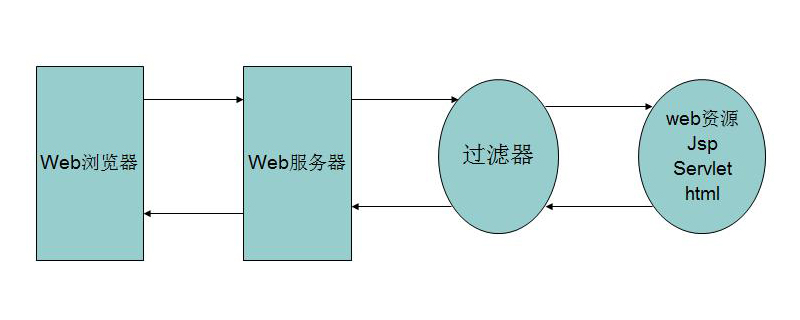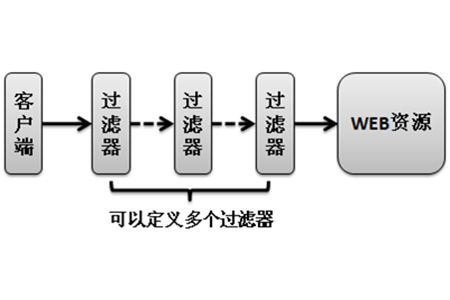What is servlet filter
The servlet filter is the middle layer component of server and client requests and responses. It is mainly used to filter browser requests and forward the filtered requests to the next resource.

[Recommended tutorial: Java tutorial]
Basic concept of servlet filter
The literal meaning of Servlet filter is that a level of filtering is required to meet the usage requirements. In fact, Servlet filter is the middle layer component of server and client requests and responses. In actual project development, Servlet filters are mainly used to filter browser requests and then transfer the filtered requests to the next resource.
Filter is a new feature added after Servlet 2.3. When you need to restrict users from accessing certain resources or process certain resources in advance when processing requests, you can use filters.
Filters are bound to WEB applications in the form of a component. Different from other WEB application components, filters are processed in a "chain" manner.

Filter
Servlet filter Fileter is a small web component that intercepts requests and responses in order to View, extract or in some way manipulate the data exchanged between the client and the server to achieve the "filtering" function. Filter usually encapsulates some functional web components. Filter provides an object-oriented modular mechanism to encapsulate tasks into a pluggable component. Filter components are declared through configuration files and dynamically proxied.
Simply put, the Servlet Filter is:
● Declarative: By declaring it in the web.xml configuration file, filters are allowed to be added and deleted without changing any application code or jsp page.
● Flexible: The filter can be used to directly call the client to perform pre-processing and post-processing work. Some flexible functions can be achieved through the filter chain.
● Portable: Since each web container today is designed based on Servlet specifications, Servlet filters are also cross-container.
● Reusable: Based on its portability and declarative configuration method, Filter is reusable.
In general, Servlet filters are modular reusable components that are flexibly declared through a configuration file. Filters dynamically intercept incoming requests and outgoing responses, adding or removing them transparently without modifying program code. It is independent of any platform and web container.
Filter working principle
Based on the description of Filter architecture, we can see the working principle of Filter, which is simply demonstrated through a flow chart:

When the client browser accesses a specific resource of the web server, after the relevant processing of the code1 code block in filter 1, it passes the request request to the filter chain. The next filter 2, (the order of the filter chain is based on the order in the configuration file) after filter 2 is processed, the request completes the corresponding logic for the Servlet passed. The process of returning a response is similar, except that the order of the filter chain is reversed, so I won’t go into details here.
Filter creation process
To write a filter, you must implement the Filter interface. Implement the methods specified by its interface.
★ Implement the javax.servlet.Filter interface
★ Implement the init method and read the initialization parameters of the filter
★ Implement the doFilter method to complete the filtering of requests or responses
★ Call the doFilter method of the FilterChain interface object to pass the request or response to the subsequent filter
A most basic filter implementation code:
java class :
import java.io.IOException;
import javax.servlet.Filter;
import javax.servlet.FilterChain;
import javax.servlet.FilterConfig;
import javax.servlet.ServletException;
import javax.servlet.ServletRequest;
import javax.servlet.ServletResponse;
public class BasicsFilter implements Filter {
public BasicsFilter() {
// 容器(服务器)启动时执行
}
/**
* @see Filter#init(FilterConfig)
*/
public void init(FilterConfig fConfig) throws ServletException {
/* 容器(服务器)时执行 */
System.out.println("======== 初始化方法 ========");
// 获取的是web.xml中配置Filter时设置的值,参数为设置值得名称,若参数不存在,则返回空
String initParam = fConfig.getInitParameter("param");
System.out.println("param ========" + initParam);
}
/**
* @see Filter#doFilter(ServletRequest, ServletResponse, FilterChain)
*/
public void doFilter(ServletRequest request, ServletResponse response, FilterChain chain) throws IOException, ServletException {
/* 在访问的时候执行 */
System.out.println("======= 开始执行doFilter ========");
// 转发到下一个组件,进行后续的处理(组件可以是一个过滤器,也可以是一个servlet)
chain.doFilter(request, response);
System.out.println("======= 结束执行doFilter ========");
}
/**
* @see Filter#destroy()
*/
public void destroy() {
// TODO Auto-generated method stub
}
}web.xml configuration:
<filter>
<filter-name>basicsFilter</filter-name>
<filter-class>com.hudongwu.filter.BasicsFilter</filter-class>
<init-param><!-- 设置在过滤器中执行初始化方法时,获取的值 -->
<param-name>param</param-name>
<param-value>studyFilter</param-value>
</init-param>
</filter>
<filter-mapping>
<filter-name>basicsFilter</filter-name>
<!-- 设置为访问该网站所有地址都需要通过该过滤器 -->
<url-pattern>/*</url-pattern>
<!-- 设置为只有访问该网站的/Helloword地址时才通过该过滤器 -->
<url-pattern>/Helloword</url-pattern>
</filter-mapping>The above is the detailed content of What is servlet filter. For more information, please follow other related articles on the PHP Chinese website!

Hot AI Tools

Undresser.AI Undress
AI-powered app for creating realistic nude photos

AI Clothes Remover
Online AI tool for removing clothes from photos.

Undress AI Tool
Undress images for free

Clothoff.io
AI clothes remover

Video Face Swap
Swap faces in any video effortlessly with our completely free AI face swap tool!

Hot Article

Hot Tools

Notepad++7.3.1
Easy-to-use and free code editor

SublimeText3 Chinese version
Chinese version, very easy to use

Zend Studio 13.0.1
Powerful PHP integrated development environment

Dreamweaver CS6
Visual web development tools

SublimeText3 Mac version
God-level code editing software (SublimeText3)

Hot Topics
 1387
1387
 52
52
 How to elegantly obtain entity class variable names to build database query conditions?
Apr 19, 2025 pm 11:42 PM
How to elegantly obtain entity class variable names to build database query conditions?
Apr 19, 2025 pm 11:42 PM
When using MyBatis-Plus or other ORM frameworks for database operations, it is often necessary to construct query conditions based on the attribute name of the entity class. If you manually every time...
 How to simplify field mapping issues in system docking using MapStruct?
Apr 19, 2025 pm 06:21 PM
How to simplify field mapping issues in system docking using MapStruct?
Apr 19, 2025 pm 06:21 PM
Field mapping processing in system docking often encounters a difficult problem when performing system docking: how to effectively map the interface fields of system A...
 What is the difference between memory leaks in Java programs on ARM and x86 architecture CPUs?
Apr 19, 2025 pm 11:18 PM
What is the difference between memory leaks in Java programs on ARM and x86 architecture CPUs?
Apr 19, 2025 pm 11:18 PM
Analysis of memory leak phenomenon of Java programs on different architecture CPUs. This article will discuss a case where a Java program exhibits different memory behaviors on ARM and x86 architecture CPUs...
 How does IntelliJ IDEA identify the port number of a Spring Boot project without outputting a log?
Apr 19, 2025 pm 11:45 PM
How does IntelliJ IDEA identify the port number of a Spring Boot project without outputting a log?
Apr 19, 2025 pm 11:45 PM
Start Spring using IntelliJIDEAUltimate version...
 In Java remote debugging, how to correctly obtain constant values on remote servers?
Apr 19, 2025 pm 01:54 PM
In Java remote debugging, how to correctly obtain constant values on remote servers?
Apr 19, 2025 pm 01:54 PM
Questions and Answers about constant acquisition in Java Remote Debugging When using Java for remote debugging, many developers may encounter some difficult phenomena. It...
 Is the company's security software causing the application to fail to run? How to troubleshoot and solve it?
Apr 19, 2025 pm 04:51 PM
Is the company's security software causing the application to fail to run? How to troubleshoot and solve it?
Apr 19, 2025 pm 04:51 PM
Troubleshooting and solutions to the company's security software that causes some applications to not function properly. Many companies will deploy security software in order to ensure internal network security. ...
 How to correctly divide business logic and non-business logic in hierarchical architecture in back-end development?
Apr 19, 2025 pm 07:15 PM
How to correctly divide business logic and non-business logic in hierarchical architecture in back-end development?
Apr 19, 2025 pm 07:15 PM
Discussing the hierarchical architecture problem in back-end development. In back-end development, common hierarchical architectures include controller, service and dao...
 How to convert names to numbers to implement sorting within groups?
Apr 19, 2025 pm 01:57 PM
How to convert names to numbers to implement sorting within groups?
Apr 19, 2025 pm 01:57 PM
How to convert names to numbers to implement sorting within groups? When sorting users in groups, it is often necessary to convert the user's name into numbers so that it can be different...




